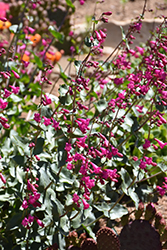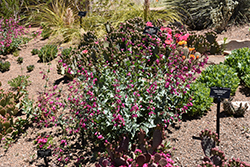Desert Beard Tongue Penstemon pseudospectabilis Height: 3 feet Spacing: 18 inches
Sunlight:
Hardiness Zone: 5a Other Names: Beardtongue Brand: Plant Select Description: This variety features mounds of blue-green, toothed foliage that remains attractive all season; striking spikes of fuchsia flowers top the plant for much of the growing season; thrives in xeric conditions; deadhead to avoid seed set for first 2 years Ornamental Features Desert Beard Tongue has masses of beautiful spikes of fuchsia tubular flowers rising above the foliage from late spring to mid summer, which are most effective when planted in groupings. The flowers are excellent for cutting. Its attractive serrated narrow leaves remain bluish-green in color with hints of silver throughout the season. Landscape Attributes Desert Beard Tongue is an herbaceous perennial with tall flower stalks held atop a low mound of foliage. Its relatively fine texture sets it apart from other garden plants with less refined foliage. This is a relatively low maintenance plant, and is best cleaned up in early spring before it resumes active growth for the season. It is a good choice for attracting butterflies and hummingbirds to your yard. Gardeners should be aware of the following characteristic(s) that may warrant special consideration;
Desert Beard Tongue is recommended for the following landscape applications;
Planting & Growing Desert Beard Tongue will grow to be about 30 inches tall at maturity, with a spread of 20 inches. When grown in masses or used as a bedding plant, individual plants should be spaced approximately 18 inches apart. It grows at a fast rate, and under ideal conditions can be expected to live for approximately 10 years. As an herbaceous perennial, this plant will usually die back to the crown each winter, and will regrow from the base each spring. Be careful not to disturb the crown in late winter when it may not be readily seen! This plant does best in full sun to partial shade. It prefers dry to average moisture levels with very well-drained soil, and will often die in standing water. It is considered to be drought-tolerant, and thus makes an ideal choice for a low-water garden or xeriscape application. This plant should not require much in the way of fertilizing once established, although it may appreciate a shot of general-purpose fertilizer from time to time early in the growing season. It is not particular as to soil type or pH. It is somewhat tolerant of urban pollution. This species is native to parts of North America. It can be propagated by division. Desert Beard Tongue is a fine choice for the garden, but it is also a good selection for planting in outdoor pots and containers. With its upright habit of growth, it is best suited for use as a 'thriller' in the 'spiller-thriller-filler' container combination; plant it near the center of the pot, surrounded by smaller plants and those that spill over the edges. It is even sizeable enough that it can be grown alone in a suitable container. Note that when growing plants in outdoor containers and baskets, they may require more frequent waterings than they would in the yard or garden. Characteristics
Applications
Features & Attributes
|

